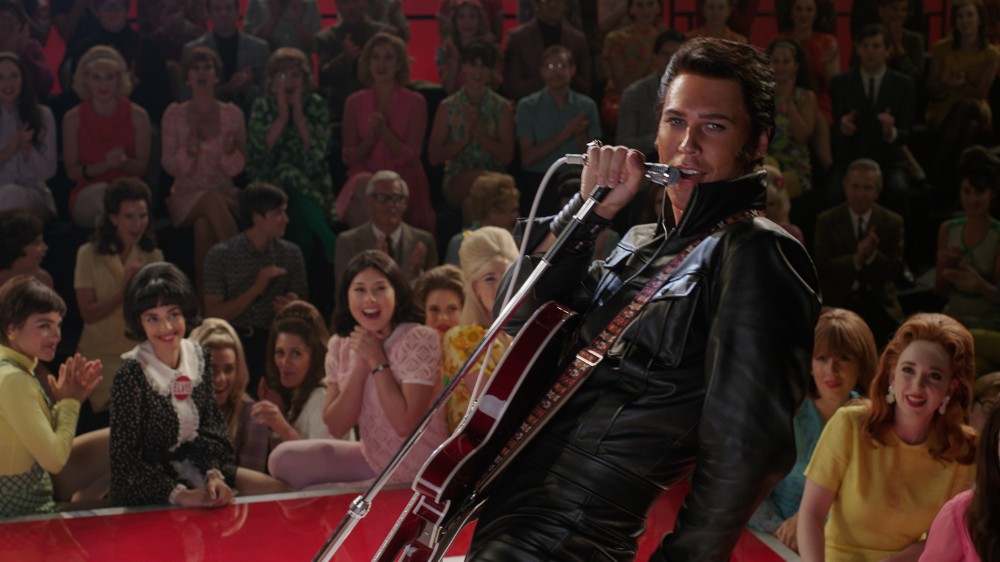
Mandy Walker put in the prep work when it came to her collaboration with Baz Luhrmann on Elvis. The cinematographer did her research in studying as many Elvis Presley movies as she could get her hands on, as well as still photos of Memphis in the 1950s and 1960s. As Luhrmann’s biopic moves into a different time period, the look of the film also changes.
Walker said that the trainspotting sequences, such as the Vegas showroom sequence and the 1968 Comeback Special, were particularly challenging for her because she had to match them to the original footage. Thus, the crew would have to get the lighting exactly right on camera given how easy it would be for fans to find that original footage online.
Though Elvis follows a typical biopic structure, spanning from Elvis’ childhood to his death in 1977, the story is told in a way that only Baz Luhrmann could envision, and he’s aided by terrific performances from Austin Butler and Tom Hanks, who co-stars as the singer’s manager, Colonel Tom Parker. While the film is told from Parker’s point of view, Butler steals the show with his uncanny turn, which peaks in the film’s final moments during a climactic performance of “Unchained Melody” where you can’t tell where the actor ends and the real Elvis begins.
Find out how Walker helped him pull it off below:
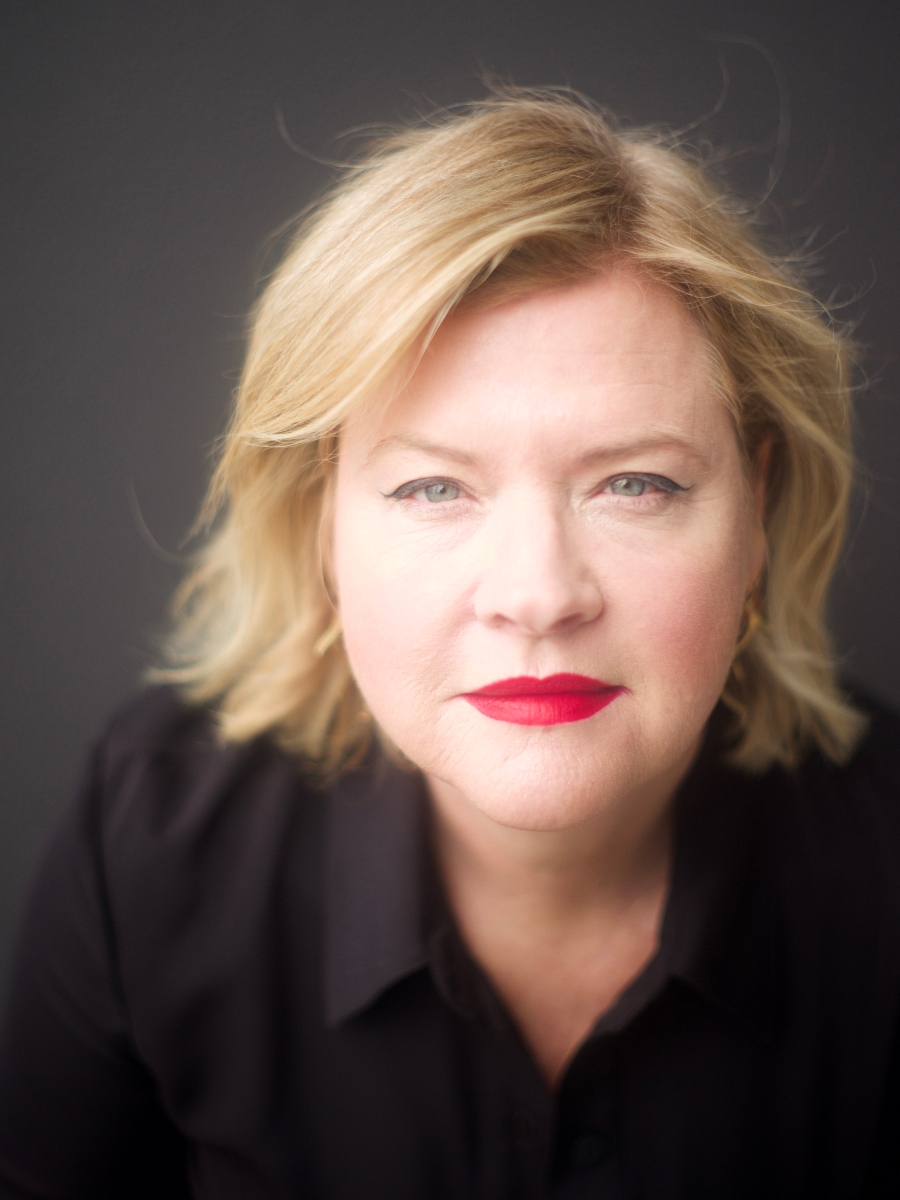
Below the Line: How quickly did you say “yes” to working on Elvis?
Mandy Walker: As fast as I could. I’ve already worked with Baz on three other projects — Australia and the two Chanel commercials. They’re commercials but we call them short films because we shot five minutes worth of footage and we spent weeks preparing, [and] days shooting. I’ve always had such a great collaboration with him. In my mind, he’s a true visionary and I would jump to work with him anytime.
BTL: How has the shorthand improved between the two of you over the years?
Walker: When I first met up with Baz — for instance, he’s always done a lot of research. On Elvis, he had done 10 years [worth]. He’d been working on this project and so he comes to me with a script and story. He’s already showing me existing footage that you can see on the internet of Elvis — for instance, the ’68 Special and That’s the Way It Is, his documentary on his first shows in Vegas. But also, he had access to his home movies.
We looked at some of his Hollywood films and photographs — a lot of photographs that he’d put together. We started talking about the story, but also the period of time [in which] Elvis existed, how he existed in American culture, and how American culture was influenced by him. It’s a big story, to start. That was very early on. It was in July 2019. Normally, he’ll talk to me like that and then I’ll go away and start doing my own research on examining and thinking of ways to photograph this story.
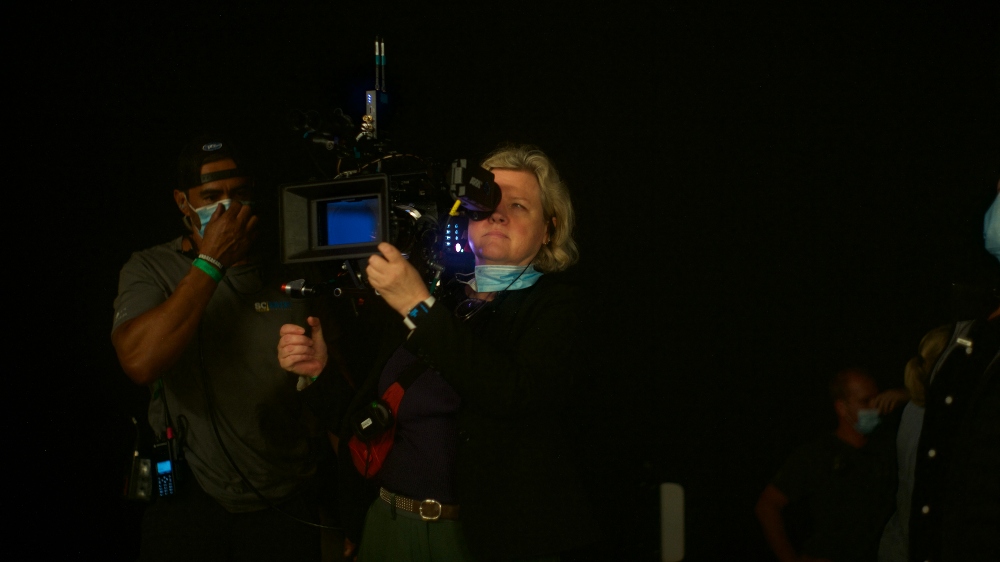
BTL: What sort of research did you do?
Walker: I studied all the films that I could possibly get on Elvis that Baz had put together for me. Also, stills photographers of the period where he existed, when he existed, and also of the location. I was looking for anything in Memphis from the ’50s and the ’60s.
I started looking at lensing — ‘how are we going to photograph this?’ I remember Baz saying to me, ‘it’s an epic story, Mandy, it has to be epic.’ I then immediately thought of shooting on 65 mm. I took Baz to Panavision and we had a 65mm camera there. We hooked up with Dan Sasaki, who’s the lens guru at Panavision, and talked to him about story. Baz and I were in there, explaining the different periods of Elvis’ life. Dan put together about five different sets of lenses that represented different periods of filmmaking. We ended up choosing Sphero lenses, which were based on lenses that were used on Lawrence of Arabia, and they’re spherical.
We decided that when Elvis went to Vegas, we would change to anamorphic. We used T series lenses. Dan took all the kinds of things that — nowadays, lenses are made to be more and more perfect and more and more crisp and clean. I had Dan put those lenses back to how they would have looked in the ’70s with all the aberrations and the drop-off. For instance, modern lenses have that blue horizontal flare, like that Star Trek-y type flare. I got him to take that out and put color back into the flares so there was blue, magenta, green, a little bit of yellow, and things like that. I think we ended up having three iterations of the lenses before we accepted that they were the right recipe.
We were shooting a lot of tests. One great thing that Baz does is, he’s a fantastic collaborator. He works with his wife, Catherine Martin, [who handles] production design and costume design, and myself, [plus] makeup and hair. We all get together and we do a lot of testing. When we were testing for Elvis’s Vista liner, which is the motor home that he has at MGM Studios, it [was] red, gold, and black. Baz said, “I know I want to do a shot that starts at the front of the liner and goes all the way to the back.” We did tests where we put the crane in there, and then they’d build it around the crane. We’d test different fabrics. I would test different lighting and color and how it affected the costume. Every part of the film, every sequence of the movie, is very meticulously tested in terms of color.
The other thing was that I looked into the different periods and how the lighting was in the different periods. For instance, in Memphis, Beale Street, and Club Handy, I looked at photographers like Saul Leiter and Gordon Parks and used them as a basis for the feel of the atmosphere there. We’d test that with the art department and with the costumes and make sure that the color palette was all sitting really perfect.
One other thing, Baz and I set up very particular lookup tables for every period and every sequence as we moved through the film. We’d go on set and we already had our lookup table dialed in and I would light to that. For instance, in the very early days, we had what we call black-and-white color. That was in Beale Street, Memphis, and Tupelo, when Elvis was 10 years old. The Pentecostal tents, that period of time going into the hayride sequence where the concert is, we pretty much desaturated, but then we brought back certain colors — greens and reds, and stayed away from a lot of blues. We found exactly the right kind of space where everything played to that look and then we stuck with it throughout the film.
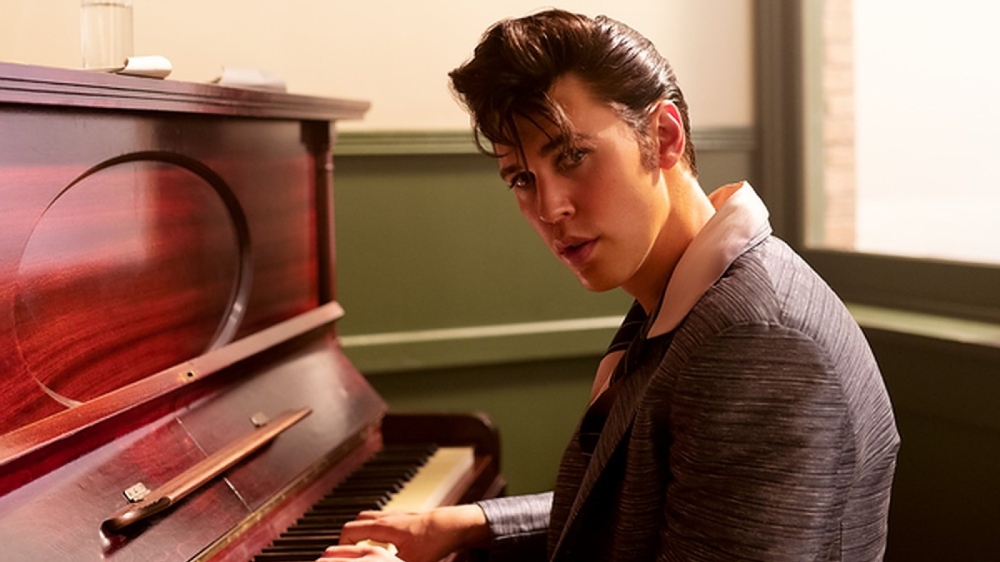
BTL: It’s my understanding that the film utilizes newer LED technology.
Walker: It was a combination of the sequences that we were replicating. For instance, [for] the ’68 special and the Vegas concert, I meticulously studied the existing footage. Myself and the lighting department went on a search for lights of the period, the constant lighting of the period, and TV lighting of the period that we would see in camera, and then added our LED lighting as well. That old-fashioned lighting is very harsh and can be quite contrasting. I added LED to that, to smooth it out a bit, to be a little bit more complimentary without losing the flavor of it. I did a lot of tests for that. We made some housing for LED lights of the period to look like period films.
The art department [also] made slightly different housing for them because I also knew that the girls in the audience were draping themselves over these lights. Elvis is right next to them, lying down on the ground, and they get really hot if you know the original ones. We put LED lighting in them so they could drape all over them, reach out, touch them, and not get burned. That was one of the reasons but also, with LED lighting, it’s more controllable in terms of the color and intensity and we can do that from the dimmer board. When I was doing the concert sequence at the Vegas showroom, I used a lot of LED lighting that was off-camera to light the backdrop and to also light all the backstage area. What we saw in [the] shot were old-fashioned par cans and Fornell lights.
BTL: I’m just trying to figure out which of my questions you haven’t already answered here. You’re a fount of knowledge!
Walker: I’m sorry. I just know what I keep saying to people. I’m so excited about this movie and I’m so proud of it. It’s so easy to talk about. It’s really special and the things that we did, I’m really proud of. The research that we did. Like I was saying, one of the things about Baz is that when he gets people together, he has a grand vision, and he’ll push people to go and challenge people to go to places they’ve never been before. I’ve never shot a [movie] or done a concert sequence like that. He told me in that first meeting, ‘Mandy, this is a film we’re gonna make and all work together to get there.’ That is the film that we made, but he makes sure that we’re all prepared and we’re all in harmony by the time we start shooting.
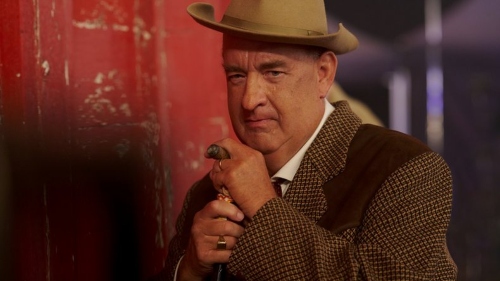
BTL: What was the most challenging aspect when it came to the actual cinematography?
Walker: It was reproducing the trainspotting sequences, especially the Vegas showroom because there was a big lighting setup. We had to shoot all the lighting changes to perfectly match the existing footage. When the follow spot comes on, when the backdrop changes color, when there’s lighting that changes with the musical beat, we had to reproduce that. We spent a couple of weeks getting that right. I do remember myself and the gaffer, in our very early pre-production, said to each other, ‘should we get some concert lighting people in to set it all up and run it?’ The next morning, we both turn up at work and [said], ‘no, we can do this. None of us have done it before, [but] we can do it. Come on!’ We did and I’m really proud of that. It was the most challenging.
We had proper dress rehearsals and we had rehearsals where all the elements were there and all my camera operators were there. For instance, when Austin was performing “Suspicious Minds,” he throws his hand up, my camera crew knew, okay, he’s gonna throw his hand out, I’m going to tilt — all kind of very meticulously planned to work with the music — and everybody [is going] to be prepared. We had three cameras on it and we had four cameras going. We plotted them all and we would rehearse all the angles. That would go to editorial and then Baz would work with editorial to make sure that we were getting what he needed.
There are the split screen elements. We planned what was going to go in what part of the frame and of course, things change but the things that we did — incorporating the archival footage with the footage that we were doing and how we were going to integrate those and some of the home movie stuff — we did a lot of testing with that. We actually shot everything on the 65 camera but some of it we degraded down into looking like Super 8 and added live grain. We did a lot of testing for that, too.
BTL: With integrating the archival, from where I was sitting while watching the film, it was like, ‘is this the real Elvis or is this Austin Butler?’ His performance was uncanny.
Walker: Yeah. It’s amazing, isn’t it? I know at one stage the editors were saying they were running them side by side and it was almost perfect. He would lift his leg at exactly the same time and flip his hair. He was perfect. He was so well rehearsed. Amazing.
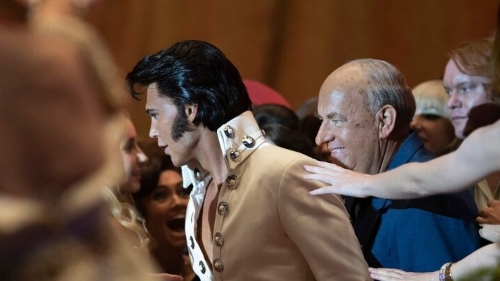
BTL: What would you say was the most challenging part when it came to trainspotting? How many times were you having to look at all the original footage?
Walker: I actually spent weeks. I went through it myself and then I just write down a plot. I would go to the locations with my camera operators and we would look at different lenses on viewfinders and work out exactly where the camera’s gonna go. I also got some zoom lenses, too, for those sequences, because there are zooms that happen at a certain point. I tried to match exactly the framing and the angle. That was a challenge, to integrate that with the lighting. I spent time in my pre-production making sure that that also was all working.
I have to also say that Baz is there the whole way. I can tell you, he’s on set like a conductor. We’ve all rehearsed everything with our dress rehearsals, and he’ll be there and he’ll know the time that the crane’s gonna come down. He stands near the camera and it’s like he makes every department feel really involved in the day-to-day creation of the images.
My team just loved being there. They love being there and being part of it because they all felt involved and collaborated with. He’s very generous with his time and makes sure that he talks to everyone and gets everybody together and that we’re all on the same page. Nothing’s left to chance. We all know what’s going to happen. That was the most challenging[stuff], but also the most fun to get right.
BTL: What was the biggest challenge that came about because of the pandemic?
Walker: In a way, for me, it was not a negative thing. What happened was [that] we had more time to prepare. I didn’t waste time [during] my time off. I stayed in Australia, and in fact, most of us did stay there. I know Austin did. He kept rehearsing and doing his own research. Same with myself. I could just think about things and stop and think about how we were approaching everything and the overall arc of the movie and just stuff like that. Just having a little bit more time, I think, was a good thing.
BTL: How long was the shutdown?
Walker: It was four months and then we went and came back and did a month of prep again to get up and running, and then we shot. It was five months altogether from — I think it was on a Friday. I remember rehearsing in the showroom and we were all there doing a rehearsal, ready to shoot on Monday, and then we got shut down. It was three days before. We were prepared, but, in a sense, it was not a bad thing that we went away and came back. I don’t think we suffered at all with the movie.
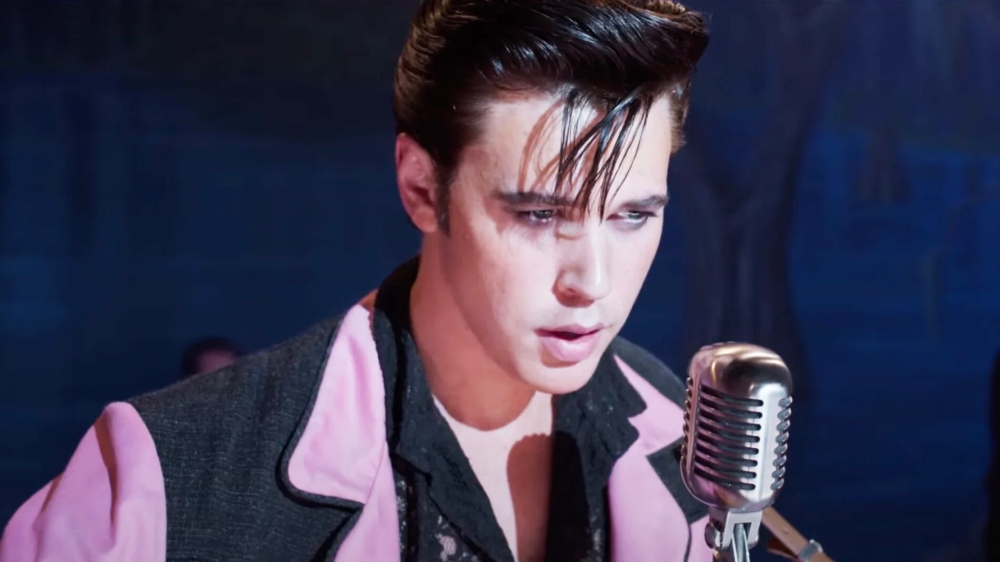
BTL: How did you first develop an interest in cinematography?
Walker: I’m one of those crazy people [who] knew that I wanted to be a cinematographer when I was about 15. It’s because I love cinema. I was really into still photography. I was doing my own still photography in the backyard in a black and white dark room. For me, it was just, like, a logical place to go. I loved movies and storytelling, and I loved photography, so I wanted to be a cinematographer. Also, the most important part of my job is to help the director tell the story. That’s how I approached my job and think of myself [as] more of an artist. I have to be a technician, and I am, but it’s about the way of creating emotion, and that’s what I love about cinema.
BTL: Do you have a favorite Elvis song?
Walker: Yes, my favorite Elvis song is “Suspicious Minds.”
BTL: What about a favorite Elvis movie?
Walker: King Creole.
BTL: I just watched that when Paramount put out the new Blu-ray.
Walker: Yes, yes. It’s still great, isn’t it?
BTL: Yeah. I just watched Jailhouse Rock for the first time over the holiday weekend.
Walker: It’s fabulous. He’s just so enigmatic and charismatic and you can’t keep your eyes off him. I think Austin captured that. There are some shots in the movie… I mean, one of the other things that I remember Baz saying to me [is] that ‘his eyes are really important and we want to see his eyes because they’re very emotive.’ I invented this little light with my lighting department that would follow the camera around on a boom pole. We’d always have this little glow and this light in his eyes. Even some of the dark scenes, I’d put it down really low so it was just a little reflection but it was a really important thing that I kept on film because his eyes are like a really… I don’t know how Austin does it but he just emotes through his eyes, and Elvis had that, too.
Elvis is now streaming on HBO Max and available to rent or buy on major VOD platforms.





